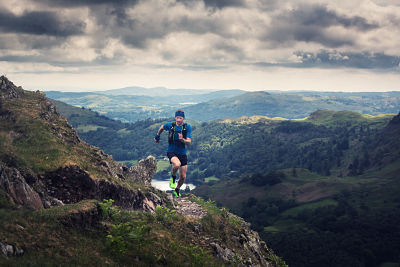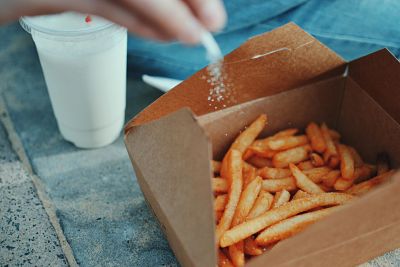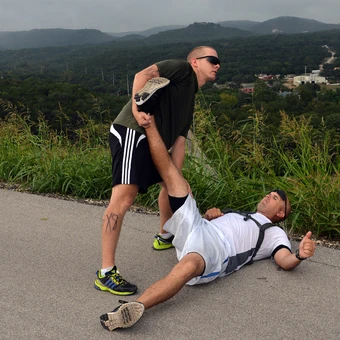There are several clichés about ultramarathon running - a massive beard is mandatory, you need to run 200 training miles every week, and races are basically eating competitions with a little light exercise thrown in. Ok, one of those is mostly true...
The moment I knew I’d love the sport of ultramarathons was when I arrived at my first aid station. It was like a children’s birthday party but all the kids had run off: a smorgasbord of sandwiches, cake, chocolate, cola, crisps, fruit (largely ignored). And it was all free! The only thing missing was the balloons and Mr Men paper plates.
I’d only been running for an hour or so and had plenty of supplies in my pack (several gels, chews, sports drink, and a huge bag of trail mix combined with various sweets), but I still sat down and tucked in anyway. Because I'm greedy.
I have a sweet tooth and found the treats irresistible. I also loaded up my already heavy pack with several handfuls of ‘just in case’ items, including a packet of sandwiches and a whole orange. Which slowed me down and, as there was another aid station about an hour later, made me feel a bit foolish.

But without really knowing it, I was already observing one of the most important rules of ultrarunning. Titchy warmonger Napoleon knew the relationship between endurance and calories too. "An army marches on its stomach," he's thought to have said.
The formula seems simple: you burn lots of calories, so you'll need to input lots of calories. But few things in ultrarunning are as mysterious as the art of fuelling. It's probably the biggest cause of DNFs.
During 100-mile ultramarathons in America "nausea and/or vomiting" was mentioned as a problem for 23% of runners, by far the highest, in a 2011 study by Martin Hoffman and Kevin Fogard.
That catch-all phrase 'tummy issues' can mean all sorts of things, including spectacular uncontrolled ejections from both ends, miscellaneous discomfort, and cramps.
I should say that compared to some runners, I seem comparatively untroubled when it comes to stomach mishaps. But I've still learned via my many ultra-picnics...
Too much, too soon
My worst ever fuelling disaster came on a hot summer's day. I turned up 10 minutes late but still had aspirations of winning.
After a handful of fast, hilly and hot miles, and wolfing down a cup of fizzy cola at an aid station, I started getting the most awful chest pains. I slowed to a walk. Then I slowed to a sit down. I felt week and dizzy.
I had an angry alien in my chest trying to escape. I was soon dry retching. It lasted for about an hour and was really painful. I still don't know for certain if it was trapped air from the cola, or simply chucking too many calories in (I had a gel, jelly babies and flapjack, all within the hour). I was over-fuelling partly because I was late and trying to catch up, when my body was already working hard to propel me up the hills and simultaneously cool me down.
I know now that this is a classic case of simply asking your body to do too many things at the same time. It was trying to propel me uphill at race-winning pace, keep me cool under a punishing sun, and digest all the sticky calories I was chucking in.
In this scenario, the body struggles to do all three at the same time and tends to neglect the tummy first. If this happened again, I'd slow down and cool down – and hopefully not try to ram so many calories in either.
I've also learned to drink my fizzy pop a good deal slower since, too.
Keeping it real
Scottish ultrarunning legend Don Ritchie called races of 50 miles "tiddlers" and for that distance and below, most runners can usually fuel as they would for a marathon, namely using sugars.
Indeed, when running at a decent pace the body struggles to digest pork pies, so gels and similar food-stuffs are the most effective calories to consume; they're transformed into energy quicker and ask the least effort of your internal areas. There's a reason you don't see Eliud Kipchoge knocking back Cornish pasties mid-marathon.
However, when you get deep into a long endurance event, at least two things happen:
- your body starts to crave more fats, proteins and salts (mostly likely because it's growing more depleted – which is inevitable as you're simply burning more calories than you can digest per hour),
- your mouth similarly doesn't want any more disgusting sugar in it. Your mouth wants a change of flavour and that's probably because your stomach does too. That family-sized tub of Tunnock's chocolate bars you brought along, thinking you were sorted for 24 hours, doesn't seem so clever now.
This is where you can personalise things.
Some people do genuinely seem to fuel their 100-milers on pork pies or nut-butter sandwiches. Record-smashing fell-runner Nicky Spinks is famous for her rice puddings and baked beans.
You'll very likely go through a salty/savoury stage too - salt and vinegar crisps often work wonders for me. But after half a day of stuffing your face – and ideally you're going for little and often, drip-feeding stuff in every 30 minutes – I get palate fatigue.
I've learned that this is where liquid calories can be a great tactic.
Tomato soup worked like spinach on Popeye when I was falling apart at my first 100-mile race, the Cotswold Way Century, and likewise the salty noodle soup at UTMB has always gone down very well (the benefit of salt is unlikely to be coincidental).
Nowadays if I have a crew, I'll include (no-dairy) flavoured milk, fruit smoothies, and soups.
Sloppy stuff can also be an excellent option; food-stuffs that require very little effort from your mouth, such as rice puddings and porridge.
Surprises and happy accidents
Nothing new on race day? It's good advice, to a point. But I think I've tried something new in every 100-mile race. From quesadillas to pizzas, Babybels to beer.
Sometimes, when palate fatigue hits hard, all your stuff seems so drab and unappealing. This is where an ace aid station captain or canny crew member comes in.
When I ran the 630-mile South West Coast Path I was very fortunate to have Tom Jones (not that one, a better one) crewing for me and he's a veteran of ultras.
After turning my nose up at most things on offer, Tom began offering me huge paper cups full of custard. Custard was a new flavour, so that went in okay. But it had mysterious lumps in it. My taste buds were so screwed at that point and I was too tired to care. He still hasn't told me what those lumps were...
I was very lucky to have Nicky Spinks crew me at UTMB and she surprised me with some local French fries, which went down a storm (again, salty). Nicky is seriously good at this stuff.

Image Credit: Unsplash (copyright free)
Another one who's very good at refreshing the palate, Nicki Lygo, surprised me when I was running the Pennine Way in 2020 with some fresh mango, when my palate seemed to have given up the ghost. It was just the right thing at the right time.
On the same run, when I was struggling for energy but also turning my nose up at everything like a spoilt brat, Jason Millward generously offered me one of his hummus and avocado sandwiches. It was a game-changer and it was all I ate for the following 24 hours (with accompanying cups of tea, obvs.).
On reflection, the hummus and avocado "sanger" combo is perfect; healthy fat and protein, in an easy to digest and flavoursome vehicle. White bread is a carbohydrate and sports dietician Renee McGregor had advised me that it's a better choice than brown bread when running because it has less fibre and will go down more easily.
I thought Jason must really know his stuff... "Nah, I just chucked together some stuff from the fridge" he later admitted.
Craaaaaaaaaaaaaamp!
I've mentioned salt a few times so far and it's been a regular theme for me when going long.
I was selected to represent Great Britain at the 2016 Trail World Championships, having finished second in the trial race. For the race in Portugal my plan had always been a conservative first half, then try to pick people off and finish strongly.
But the start of the second half coincided with the temperatures rising and being caught out with not enough liquid. The tell-tale signs are obvious now, but I didn't know what was going on initially, when I became paralysed with leg muscle spasms, initiating from my adductors.
I literally could not move forward. I was lucky to get a massage, more liquid in and was kindly offered a variety of things from little tubes by fellow runners. I hobbled to the finish line, but my race was ruined.

I'd never had cramps before, didn't understand what had caused them or how to cure them. The science may be at loggerheads on this subject, but for me they're definitely related to salt loss and dehydration.
I've had two more episodes, both thankfully fairly quickly resolved with sodium and liquid. But since my Sweat Test and upping my electrolyte intake, none.
Find what works for you
A few more things I've learned: we're all a bit different, so the baby food pouches (no really) that work for your mate might not necessarily work for you. Try all of that out in training, where it's thought you can teach your gut to take on more than the standard benchmark 90g carbs/hour.
If you run through the night, consider cleaning your teeth/mints of chewing gum, to freshen up your palate.
Lastly: drink tea.
Damian's book, In It For The Long Run (Vertebrate Publishing), is out in May.
